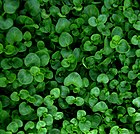Note: This is a project under development. The articles on this wiki are just being initiated and broadly incomplete. You can Help creating new pages.
Difference between revisions of "Mentha requienii - Corsican mint"
(→Commonly seen growing in areas) |
|||
| Line 1: | Line 1: | ||
[[File:Mentha requienii 8601.JPG|thumb|right|''Corsican mint'', ''Mentha requienii'']] | [[File:Mentha requienii 8601.JPG|thumb|right|''Corsican mint'', ''Mentha requienii'']] | ||
| − | |||
'''Corsican mint''' is a herb and species of mint, native to Corsica, Sardinia, and mainland Italy, and naturalized in Portugal and in the British Isles. It is a very low-growing species with bright green leaves and a strong minty aroma. | '''Corsican mint''' is a herb and species of mint, native to Corsica, Sardinia, and mainland Italy, and naturalized in Portugal and in the British Isles. It is a very low-growing species with bright green leaves and a strong minty aroma. | ||
==Uses== | ==Uses== | ||
| − | {{Uses| | + | {{Uses|Fever}}, {{Uses|Digestive disorders}}, {{Uses|Headaches}}, {{Uses|Minor ailments}}. |
==Parts Used== | ==Parts Used== | ||
Revision as of 18:31, 12 April 2019
Corsican mint is a herb and species of mint, native to Corsica, Sardinia, and mainland Italy, and naturalized in Portugal and in the British Isles. It is a very low-growing species with bright green leaves and a strong minty aroma.
Contents
- 1 Uses
- 2 Parts Used
- 3 Chemical Composition
- 4 Common names
- 5 Properties
- 6 Habit
- 7 Identification
- 8 List of Ayurvedic medicine in which the herb is used
- 9 Where to get the saplings
- 10 Mode of Propagation
- 11 How to plant/cultivate
- 12 Commonly seen growing in areas
- 13 Photo Gallery
- 14 References
- 15 External Links
Uses
Fever, Digestive disorders, Headaches, Minor ailments.
Parts Used
Chemical Composition
The main constituents that resulted were pulegone (78%), menthone (0.5%), isomenthone (18%), isopulegone (1.3%) and limonene (1.76%). In vitro antifungal activity is evaluated in order to identify new means that could be helpful in the prevention of contamination in indoor environments.[1]
Common names
| Language | Common name |
|---|---|
| Kannada | |
| Hindi | |
| Malayalam | |
| Tamil | |
| Telugu | |
| Marathi | NA |
| Gujarathi | NA |
| Punjabi | NA |
| Kashmiri | NA |
| Sanskrit | |
| English | Mint |
Properties
Reference: Dravya - Substance, Rasa - Taste, Guna - Qualities, Veerya - Potency, Vipaka - Post-digesion effect, Karma - Pharmacological activity, Prabhava - Therepeutics.
Dravya
Rasa
Katu (Pungent)
Guna
Laghu (Light), Ruksha (Dry), Tikshna (Sharp)
Veerya
Ushna (Hot)
Vipaka
Katu (Pungent)
Karma
Kapa, Vata
Prabhava
Habit
Identification
Leaf
| Kind | Shape | Feature |
|---|---|---|
| Simple | Foliage Color is Dark Green, Foliage Texture is Fine and Foliage Sheen is Matte |
Flower
| Type | Size | Color and composition | Stamen | More information |
|---|---|---|---|---|
| Unisexual | 2-4cm long | Lavender | Single | Flower Interest is Showy, Fragrant Flowers are Not there |
Fruit
| Type | Size | Mass | Appearance | Seeds | More information |
|---|---|---|---|---|---|
| Showy Fruit is Not there and Edible Fruit also Not there | Fruit Color is Sandy Brown | {{{6}}} |
Other features
List of Ayurvedic medicine in which the herb is used
- Vishatinduka Taila as root juice extract
Where to get the saplings
Mode of Propagation
How to plant/cultivate
Succeeds in most soils and situations so long as the soil is not too dry[3]
Commonly seen growing in areas
Ground Cover, Cultivated Beds, Wet meadows, Pozzines.
Photo Gallery
References
External Links
- Ayurvedic Herbs known to be helpful to treat Fever
- Ayurvedic Herbs known to be helpful to treat Digestive disorders
- Ayurvedic Herbs known to be helpful to treat Headaches
- Ayurvedic Herbs known to be helpful to treat Minor ailments
- Herbs with Leaves used in medicine
- Herbs with common name in English
- Habit - Herb
- Index of Plants which can be propagated by Seeds
- Herbs that are commonly seen in the region of Ground Cover
- Herbs that are commonly seen in the region of Cultivated Beds
- Herbs that are commonly seen in the region of Wet meadows
- Herbs that are commonly seen in the region of Pozzines
- Herbs




